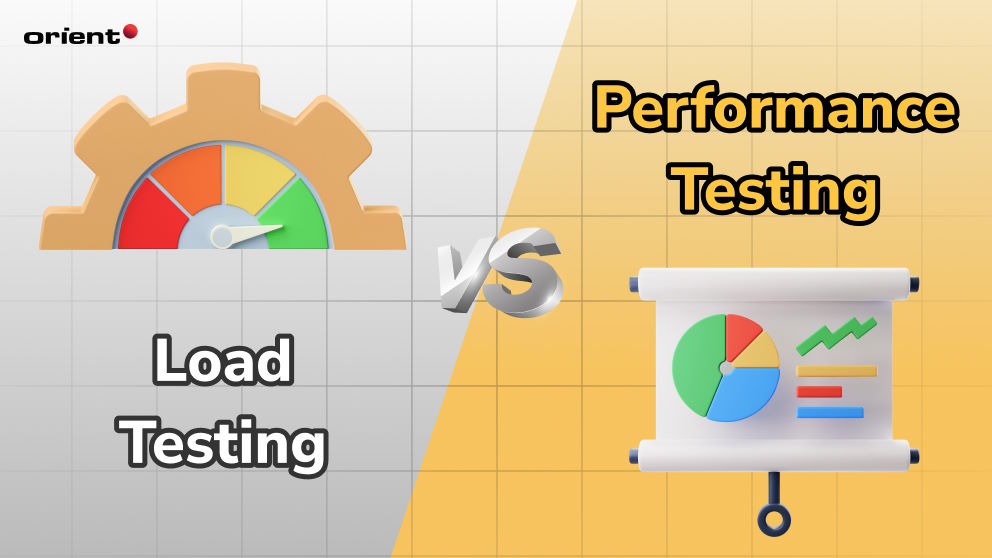Load Testing Vs. Performance Testing: What Are the Main Differences?

Content Map
More chaptersIn software development, quality assurance is significantly important in securing seamless performance and the quality of the final outcomes. And speaking of QA, testing is an indispensable part. There are multiple types of software testing, and each plays a different role in the development process and serves different purposes. For example, unit testing is conducted to verify the business logic, while integration testing validates the interaction between components. In this article, we are about to mention two testing methods used to evaluate the maximum capacity of an application or software as well as how it performs under specific conditions, and they are performance testing and load testing. However, these two types of tests are often confused over each other for their likenesses. Therefore, we are going to make it clear by outlining all the primary differences between them.
What Is Performance Testing?
It is a type of software testing. It is utilized to measure the response time of an application, system, or software when it is under a normal load limit.
The main focus of a performance test is to evaluate how a system behaves in terms of responsiveness, stability, scalability, and resource usage under a specific workload. Or in other words, a performance test helps to check how many users can work with the system simultaneously without slowing it down. It is important to note that performance tests are not only about verifying the system performance by speed but also about making sure that the system can handle the intense loads without any errors or data loss.
Ultimately, the goal of QA teams when conducting performance tests is to get the performance metrics and eliminate bottlenecks in the SDLC. Performance tests encompass multiple forms of testing besides load tests, such as stress testing, scalability testing, endurance testing, capacity testing, and responsiveness testing.
Types of performance testing:
- Stress Testing: A stress test is carried out to check the system’s response to an extreme load. The main purpose of conducting a stress test is to find the breaking point of the system.
- Scalability Testing: This is executed to identify whether the system can be scaled up or not when there is an increase in the user load.
- Endurance Testing: The main purpose of conducting an endurance test is to find out how long the system can sustain its performance under a prolonged load.
- Capacity Testing: A capacity test is conducted to verify the maximum capacity of the system to check whether the system can be scaled up to accommodate more users without any issues.
- Responsiveness Testing: As its name suggests, a responsiveness test is performed to check how quickly the system can respond to the changes in load.
- Spike Testing: A spike test is carried out to check the system’s response to a sudden increase or decrease in load.
- Volume Testing: A volume test is executed to check the system’s response to a large volume of data.
The Role of Performance Testing in Software Development
Performance testing offers various benefits that help to guarantee the quality of a system, application, or software. These are some visible ones:
Verify Fundamental Features
Conducting performance tests enables you to validate the core functions of a system or application to ensure they perform properly without any errors.
Enables Early Feedback
Performance tests can be conducted at various stages of the software development lifecycle. And conducting it early in the SDLC provides an opportunity to get feedback about the system’s performance at an early stage, which ultimately saves time and money and mitigates the risk of potential performance issues in the future.
Optimize User Experience
Improve User Experience: Performance testing provides actionable insights about the system’s performance and response time from a user’s perspective. No doubt, a system that is slow and unresponsive is likely to frustrate users. Based on that, you can respond to the users’ input shortly and ensure a good user experience, which would lead to the success of the final version of the applications.
Ensures System Stability
A system that can sustain prolonged loads without any errors or data loss is considered to be stable. Performance testing helps to identify performance bottlenecks and fix them before the system goes live to ensure its stability.
Maximize Resource Utility
Performance tests help developers to identify areas where they can optimize the use of resources, such as CPU, memory, and database, and minimize wastage in the long run.
What Is Load Testing?
Load testing is one type of non-functional testing that examines the behaviors of software, application, or system when it is under an expected high load. The purpose of a load test is to see how the system reacts to the peak load and whether it sustains and remains stable.
Normally in a load test, an application or software is put into a scenario simulated in that multiple users are accessing it at the same time. A load test often starts with low numbers of virtual users and gradually increases the user load to check at which point the system performance is impacted. Through this test, developers can measure the system’s sustainability. Ultimately, load testing helps to identify bottlenecks or system performance issues that may occur when the system is under heavy load volumes of concurrent users.
Load tests and stress tests are often used together, and they are quite similar as well since they are aimed at testing the upper limit of an app, system, or software. The only difference is that in a stress test, the system is put into extreme loads to check if it can still function properly as when under normal load.
The Role of Load Testing in Software Development
Like performance tests, conducting load tests also gives the development team some advantages, which are as follows:
Reduce Downtime
Downtime is often caused by insufficient resources to handle traffic spikes. Load testing can help identify the maximum load capacity of a system before it goes live. Therefore, you can make sure that the system is able to cope with sudden traffic surges and maintain stability without any downtime. This also contributes to a better user experience.
Facilitate Scalability
If a system or application fails to handle the expected load, it may result in memory leaks and resource wastage. This is when load tests help you validate the system’s capacity and work on the scalability afterward.
Detect Inefficient Code
Poorly written code impacts the process of utilizing and optimizing your resources one way or another; however, it is difficult to identify in normal circumstances. Load testing can help to simulate a high user load on the system, which would detect any inefficient code and help you to refactor it before it causes any significant problems.
Improve User Experience & Retention
End-users may have uneasy experiences when your system or application breaks down due to overload. Load testing enables the development team to better prepare the system for handling large volumes of users, thereby preventing crashes and securing user experience. As a result, a good user experience will lead to better user retention.
Load Testing Vs. Performance Testing Comparison: How Do They Differ?
Despite some slightly similar aspects of performance and load testing, they are not interchangeable. Let’s look closer into their distinctive features in the comparison below:
- Basically, performance testing is a larger scope of software testing that includes multiple testing types, including load tests, whereas load testing is only a type of performance testing.
- One significant difference between performance and load testing is their focus area. Performance tests check the benchmark behaviors of a system under a normal load, while load tests target the upper limits of a system under intense loads. In brief, performance tests verify the responsiveness, reliability, stability, and scalability of a system, while load tests check its sustainability.
- The load tests are conducted at the threshold limit, whereas the performance tests are done above and below the load limit.
- Last but not least, load testing tools are more costly than performance testing tools.
Summary

Both performance testing and load testing are integral parts of quality assurance. After going through this comparison, we expect you to understand what these testing methods are about and how they differ. Here is a short side-by-side comparison of differences between performance testing and load testing:
Performance Testing
- It is an umbrella term covering multiple types of software testing methods, including load tests.
- It checks the system’s behaviors under normal load.
- It is conducted at below or above the limit load.
- In a performance test, the responsiveness, reliability, stability, and scalability of a system are targeted.
- Performance testing tools are less costly.
Load Testing
- It is one type of performance testing
- It checks the system’s behaviors under intense load.
- It is conducted at the threshold limit of load.
- In a load test, the sustainability of a system is focused on.
- Load testing tools are more costly.







